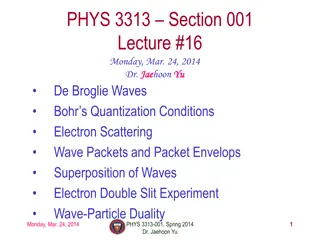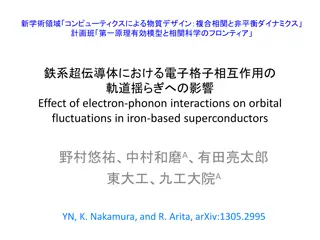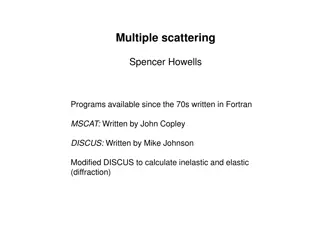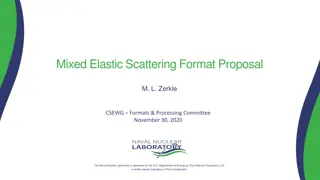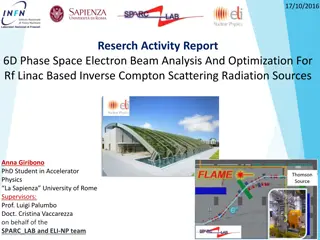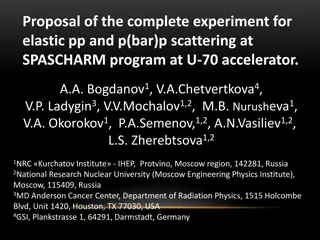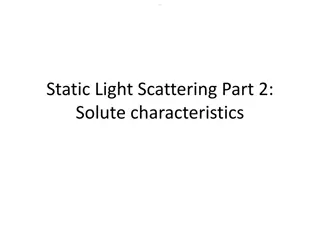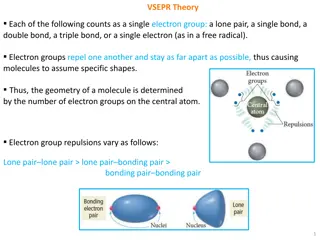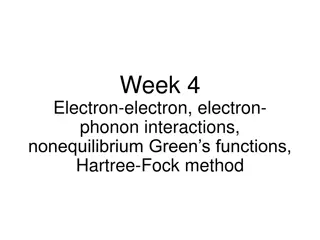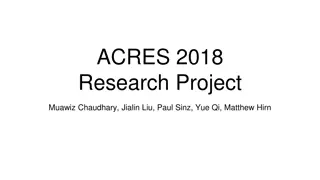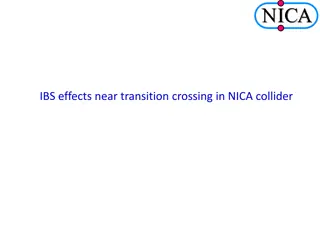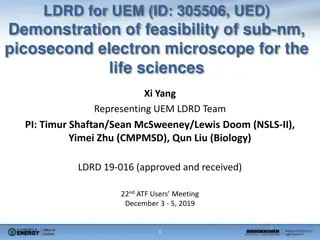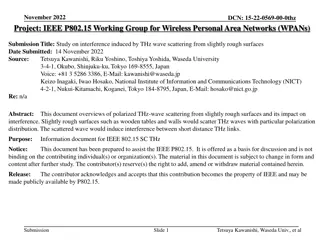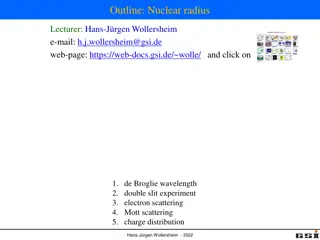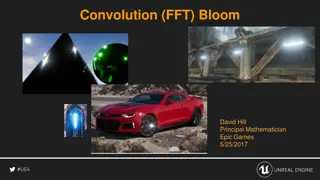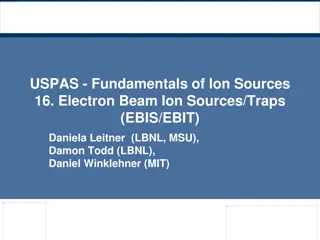Types of groups and reactions
This information discusses electron-donating groups (EDGs) and electron-withdrawing groups (EWGs), their effects on molecule reactivity, examples of each group, nucleophiles, and electrophiles. EDGs increase electron density, making nucleophiles stronger, while EWGs decrease electron density, making
0 views • 14 slides
Advanced Techniques in Materials Science: Transmission Electron Microscopy
Explore the advanced techniques used in materials science, focusing on Transmission Electron Microscopy (TEM). Learn about the challenges with optical microscopes, the principles of TEM imaging, and the application of scattering theory in electron microscopy. Discover how TEM offers higher resolutio
3 views • 19 slides
Understanding Ionic and Metallic Bonding in Chemistry
Explore the concepts of ions, electron dot structures, the octet rule, cations, and anions in Chapter 7. Learn how elements achieve stability through electron configurations, and practice writing electron dot structures and naming ions. Understand the differences between cations and anions and how t
1 views • 52 slides
Advanced Microbunched Electron Cooling for EIC Design Overview
Microbunched electron cooling is a cutting-edge technique proposed for the Electron-Ion Collider (EIC) design, aimed at enhancing beam properties through coherent electron interactions. The concept utilizes Coherent Electron Cooling (CeC) and broad-band amplification in the form of Micro-bunched Ele
1 views • 16 slides
Understanding Electron Configurations and Atom Properties
Explore topics including electron configuration, full shells, atomic numbers, and properties of elements like Ytterbium, Bromine, Mercury, Magnesium, and Europium. Learn about isotopes, ions, and orbital electron distribution in atoms like Europium and Nitrogen, as well as practice completing electr
1 views • 10 slides
Understanding Cathode Ray Tubes (CRT) in Oscilloscopes
Cathode Ray Tubes (CRTs) are key components in oscilloscopes, modulating and accelerating electron beams to create images of electrical waveforms, radar targets, and more. Unlike TVs, CRTs in oscilloscopes use electrostatic deflection for precise beam control. The electron gun assembly consists of a
0 views • 18 slides
Exploring the Free Electron and Nearly Free Electron Models in Solid State Physics
The Free Electron Model postulates that electrons in metals move freely without interacting with crystal ions, yielding insights on conductivities. Developed by Arnold Sommerfeld, it combines the Drude model with quantum mechanics. Conversely, the Nearly Free Electron Model leans on quantum mechanic
0 views • 22 slides
Understanding the 18-Electron Rule in Transition Metal Organometallic Compounds
The 18-electron rule governs the stability of transition metal organometallic compounds by requiring the sum of metal d electrons and ligand-supplied electrons to be 18. This rule highlights the importance of electron count and ligand characteristics in forming stable complexes. Key concepts include
0 views • 15 slides
Accelerator Technology R&D Targets and Sources Overview
The SnowMass2021 Accelerator Frontier AF7 focuses on Accelerator Technology R&D, exploring targets and sources such as high brightness electron sources, muon sources, and high intensity ion sources. The community planning meeting discussed various Letter of Interest submissions outlining innovative
0 views • 7 slides
Exploring De Broglie Waves, Bohr's Quantization, and Electron Scattering in Physics
Discover the fascinating concepts of De Broglie waves, Bohr's quantization conditions, and electron scattering in physics. Delve into the wave-particle duality, electron double-slit experiments, and the groundbreaking observations by Davisson and Germer. Uncover the implications of mass particles ha
0 views • 23 slides
Gravity Waves as a Mechanism of Coupling Oceanic and Atmospheric Acoustic Waveguides to Seismic Sources
Direct excitation of acoustic normal modes in horizontally stratified oceanic waveguides is negligible for shallow earthquakes due to velocity disparities. This study evaluates the contribution of scattering by hydrodynamic waves in generating abyssal T-waves. The research explores the role of scatt
1 views • 6 slides
Understanding Electron Correlation and Basis Sets in Molecular Calculations
Polarized basis sets describe the electron density polarization in atoms and molecules to improve accuracy in computed geometries and frequencies. Diffuse basis sets are recommended for calculating electron and proton affinities. Electron correlations account for electron interactions in molecular c
0 views • 8 slides
Understanding Electron-Phonon Interactions in Iron-Based Superconductors
This discussion explores the effects of electron-phonon interactions on orbital fluctuations in iron-based superconductors. Topics covered include ab initio downfolding for electron-phonon coupled systems, evaluation methods such as Constrained Random Phase Approximation (cRPA), Constrained Density-
0 views • 12 slides
Understanding Microwave Tubes and Klystron Technology
Microwave tubes play a crucial role in high-frequency applications due to their efficiency and operating principles. Conventional tubes face limitations beyond 100MHz, while efficient microwave tubes utilize electron velocity modulation for power conversion. Klystron tubes, such as Reflex Klystron,
4 views • 19 slides
Beam Energy Calibration with Compton Scattering Method
The CEPC beam energy calibration with Compton scattering method led by Yongsheng Huang and the CEPC energy calibration working group involves collaborations with various institutions and organizations. The project includes detailed physics requirements, system designs, and implementation plans for b
0 views • 14 slides
Understanding PN Junction in Semiconductors
Mobility in semiconductors is affected by scattering events as temperature increases, with impurity scattering dominating at low temperatures and lattice scattering at high temperatures. A p-n junction is the interface between p-type and n-type semiconductor materials, with excess holes on the p-sid
0 views • 15 slides
Understanding Multiple Scattering Programs in Fortran for Neutron Diffraction and Inelastic Analysis
Multiple scattering programs like MSCAT and DISCUS, written in Fortran since the 70s, are essential tools for neutron diffraction and inelastic analysis. These programs allow for the calculation of neutron cross-sections, scattering angles, and sample geometries. The results obtained include elastic
0 views • 8 slides
Ion Beam Intensity Enhancement Through Electron Heating in Collider Experiments
The study discusses electron heating of ions in collider experiments at the Collider V. ParkhomchukBINP facility in Novosibirsk. It explores the effects of electron cooling on ion beams, ion beam oscillations, losses, and ion beam intensity enhancement. Various factors such as ion charge, classical
0 views • 9 slides
Understanding Semiconductor Conductivity and Scattering Mechanisms
In the study of semiconductor conductivity, the concept of degenerate and non-degenerate semiconductors is discussed, showcasing the impact of doping levels. The conductivity equation is explored in terms of electron and hole mobilities and densities. The role of scattering mechanisms, such as latti
0 views • 18 slides
Understanding the 18e Rule in Organometallic Compounds
The 18e rule dictates the electronic structures of many organometallic compounds, emphasizing a total valence electron count of 18 on the central metal atom for stability. Electron counting methods like the Covalent and Ionic models assist in determining the electron distribution among ligands. The
0 views • 8 slides
Understanding Electron Configurations and the Periodic Table in Chemistry
Explore the world of electron configurations in atoms, subshells, and electron arrangement using the periodic table. Learn about the organization of electrons in subshells, different ways to represent electron arrangements, and how to determine electron configurations based on the periodic table. Di
0 views • 12 slides
Mixed Elastic Scattering Format Proposal
This proposal focuses on introducing a Mixed Elastic Scattering format to address the need for a more rigorous treatment of thermal elastic scattering effects in selected nuclides. The format extension, compatible with ENDF-6, supports advanced moderator development without impacting existing TSL ev
0 views • 6 slides
Electron Beam Analysis and Optimization for RF Linac in Inverse Compton Scattering
This research activity report discusses the analysis and optimization of a 6D phase space electron beam for RF Linac-based Inverse Compton Scattering radiation sources. It covers the SPARC_LAB Thomson Source and ELI-NP GBS, including experiments, simulations, and studies on beam parameters and struc
0 views • 26 slides
Investigation of Spin Observables in Elastic pp and p(bar)p Scattering at SPASCHARM Program
Measurements of spin observables in elastic pp and p(bar)p scattering at 16 GeV will be conducted at the SPASCHARM program using a unique setup with polarized proton and antiproton beams. The experiment aims to extend the energy range for spin studies and compare elastic scattering in pp and p(bar)p
0 views • 24 slides
Understanding Light Scattering Part 2: Solute Characteristics and Applications
Light scattering can provide valuable insights into solute characteristics such as molecular weight, radius of gyration, and second virial coefficient. By analyzing scattering data, information about individual particles and their arrangement in solution can be obtained. Techniques like Zimm or Guin
0 views • 20 slides
Understanding VSEPR Theory for Molecular Geometry
VSEPR theory explains how the arrangement of electron groups around a central atom determines the shape of molecules based on the repulsions between different types of electron groups. The geometry of a molecule is influenced by factors such as lone pairs, single, double, or triple bonds, and their
0 views • 16 slides
Understanding Scattering Phenomenon: Key Concepts and Applications
Scattering is a fundamental process involving the interaction of light with particles, impacting various fields such as physics and environmental science. Learn about its measurement theory, dependence on physical properties, and examples like Rayleigh theory for small particle scattering and impact
0 views • 36 slides
Understanding Microscopes: Light vs. Electron Microscopes
Learn about the differences between light microscopes (LM) and electron microscopes (EM), including their magnification power, resolving power, and key parts. Explore the types of electron microscopes such as Transmission Electron Microscope (TEM) and Scanning Electron Microscope (SEM) for advanced
0 views • 8 slides
Understanding Electron Microscopy: A Comprehensive Overview
Electron microscopy (EM) is a powerful technique used in biomedical research to visualize detailed structures of various specimens at high resolution. The process involves an electron gun, electromagnetic lenses, specimen holder, and imaging systems. There are two main types of electron microscopes:
0 views • 12 slides
Understanding Interfacial Defects and Microscopy in Materials Science
Interfacial defects are boundaries separating regions with different crystal structures, like grain boundaries in polycrystalline materials. Microscopic examination distinguishes between macroscopic and microscopic dimensions, analyzed through optical and electron microscopy methods. Electron micros
0 views • 9 slides
Understanding Scanning Electron Microscopes (SEM) and Electron Sources
Scanning Electron Microscopes (SEMs) utilize focused electron beams to produce high-resolution images by interacting with a sample's electrons. The electron source, such as the electron gun, plays a crucial role in forming fine electron beams for imaging purposes. Different types of electron sources
0 views • 12 slides
Quantum Interactions: Electrons, Phonons, and Hubbard Interaction
Exploring the complexities of electron-electron and electron-phonon interactions, nonequilibrium Green's functions, Hartree-Fock method, Coulomb's law, quantum operator forms, Hubbard interaction, and electron-phonon interactions from first principles. The interactions delve into the behavior of cha
0 views • 20 slides
Design of a 10 MeV Beamline for E-beam Irradiation at UITF Wastewater Facility
This paper discusses the design of a 10 MeV beamline at the Upgraded Injector Test Facility for electron beam irradiation, focusing on wastewater treatment for environmental restoration. The use of electron beam irradiation is highlighted as an effective method to remove pollutants like 1,4 dioxane
0 views • 9 slides
Advancements in Machine Learning for Electron Density Prediction
Electron density is crucial for understanding atomic bonding. This research project explores using machine learning, specifically a Unet architecture, to predict electron density in a Lithium-Oxygen-Lithium system. The data set was generated by varying the positions of Lithium atoms and calculating
0 views • 8 slides
Insights into Intra-Beam Scattering Effects and Plasma Dynamics in Particle Colliders
Intra-Beam Scattering (IBS) effects near transition crossing in NICA collider result in energy exchange between different degrees of freedom, impacting beam size, luminosity, and lifetime. The IBS phenomenon is crucial for circular machines, with theoretical developments by Piwinski and Bjorken shap
0 views • 15 slides
Advancing Electron Microscopy in Life Sciences through UEM Feasibility Demonstration
Demonstration project of the feasibility of a sub-nanometer, picosecond electron microscope for life sciences applications. The goal is to image biological cells with resolution below 200nm using a proof-of-concept system integrated with existing UED setup. The project builds on previous successes i
0 views • 14 slides
Study on THz Wave Scattering from Slightly Rough Surfaces: Interference and Implications
Overview of polarized THz wave scattering from slightly rough surfaces such as wooden tables and walls. The document discusses the induced interference between short-distance THz links and presents a model of electromagnetic wave scattering with examples of experimental and numerical results. Potent
0 views • 17 slides
Insights into Nuclear Radius and Electron Scattering Experiments
Delve into the realm of nuclear physics with a focus on nuclear radii and electron scattering experiments led by lecturer Hans-Jürgen Wollersheim. Explore topics such as de Broglie wavelength, double-slit experiment, Mott scattering, charge distribution, and the use of electrons as probes to measur
0 views • 9 slides
Understanding Bloom Effects in Game Design
Bloom effects, such as weak scattering and convolution, enhance the visual appeal of games by simulating light scattering. They add realism and customization options to game graphics, improving the overall visual experience. Weak scattering causes subtle yet impactful effects like glare and diffract
1 views • 14 slides
Fundamentals of Electron Beam Ion Sources for Ionization: A Comprehensive Overview
Delve into the intricacies of Electron Beam Ion Sources (EBIS) and Electron Beam Ion Traps (EBIT) with a focus on their historical development, key operating principles, and main concepts. Explore the production of high charge states for accelerator applications, electron beam confinement, ionizatio
0 views • 10 slides









